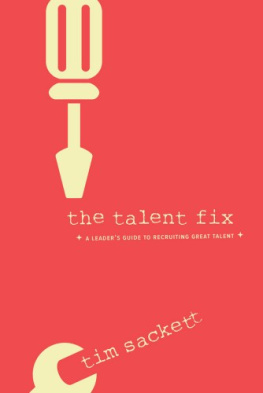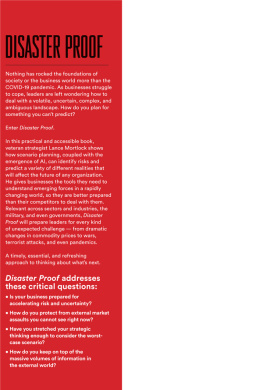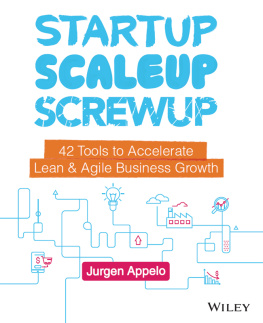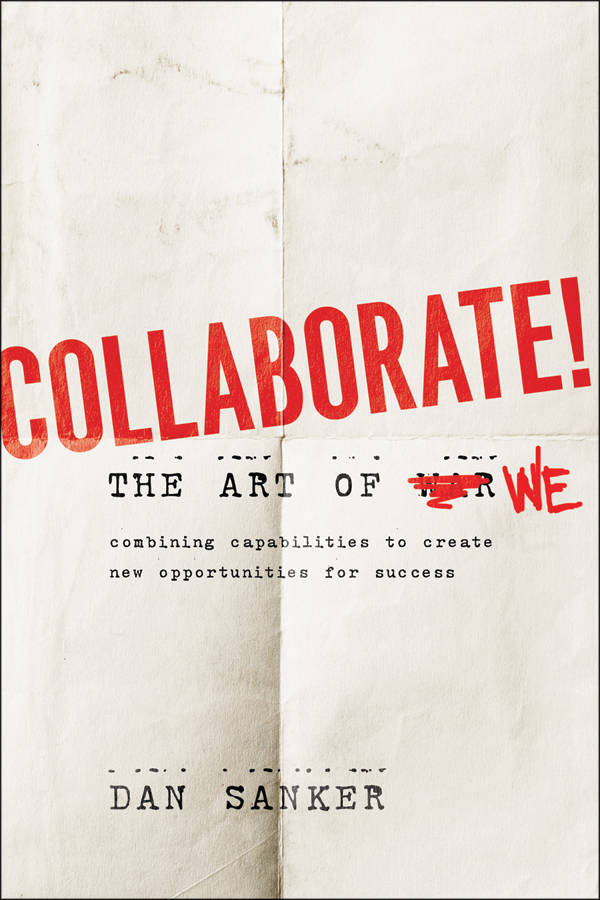CONTENTS
Praise for Collaborate: The Art of We
Too many cooks spoil the brothnot if you read this book and follow Dans example. Done right, collaboration is the key to harnessing the benefits of open innovationbe it on an individual, corporate, or even national level.
Martin Ihrig The Wharton School, University of Pennsylvania; and I-Space Institute, LLC
Every innovation stems from some external spark. The more you collaborate, the greater the chances of this happening. Dan gets this. Read this book and learn how you can MAKE this happen instead of waiting for it to happen TO YOU.
Matthew Graczyk CEO, Coupeez Inc.
Dan lives by the rules of servant leadership that build the open, honest, and trusting foundation for collaboration. Sharing that in the book transforms his conduct into a world-changing pursuit.
Jeff Amerine Gravity Ventures

Copyright 2012 by Dan Sanker. All rights reserved.
Published by Jossey-Bass
A Wiley Imprint
One Montgomery Street, Suite 1200, San Francisco, CA 94104-4594 www.josseybass.com
No part of this publication may be reproduced, stored in a retrieval system, or transmitted in any form or by any means, electronic, mechanical, photocopying, recording, scanning, or otherwise, except as permitted under Section 107 or 108 of the 1976 United States Copyright Act, without either the prior written permission of the publisher, or authorization through payment of the appropriate per-copy fee to the Copyright Clearance Center, Inc., 222 Rosewood Drive, Danvers, MA 01923, 978-750-8400, fax 978-646-8600, or on the Web at www.copyright.com . Requests to the publisher for permission should be addressed to the Permissions Department, John Wiley & Sons, Inc., 111 River Street, Hoboken, NJ 07030, 201-748-6011, fax 201-748-6008, or online at www.wiley.com/go/permissions .
Limit of Liability/Disclaimer of Warranty: While the publisher and author have used their best efforts in preparing this book, they make no representations or warranties with respect to the accuracy or completeness of the contents of this book and specifically disclaim any implied warranties of merchantability or fitness for a particular purpose. No warranty may be created or extended by sales representatives or written sales materials. The advice and strategies contained herein may not be suitable for your situation. You should consult with a professional where appropriate. Neither the publisher nor author shall be liable for any loss of profit or any other commercial damages, including but not limited to special, incidental, consequential, or other damages. Readers should be aware that Internet Web sites offered as citations and/or sources for further information may have changed or disappeared between the time this was written and when it is read.
Jossey-Bass books and products are available through most bookstores. To contact Jossey-Bass directly call our Customer Care Department within the U.S. at 800-956-7739, outside the U.S. at 317-572-3986, or fax 317-572-4002.
Wiley also publishes its books in a variety of electronic formats and by print-on-demand. Some material included with standard print versions of this book may not be included in e-books or in print-on-demand. If the version of this book that you purchased references media such as CD or DVD that was not included in your purchase, you may download this material at http://booksupport.wiley.com . For more information about Wiley products, visit www.wiley.com .
Library of Congress Cataloging-in-Publication Data
Sanker, Dan, 1965
Collaborate : the art of we / Dan Sanker.
p. cm.
Includes bibliographical references and index.
ISBN 978-1-118-11472-8 (cloth); 978-1-118-18055-6 (ebk.);
978-1-118-18056-3 (ebk.); 978-1-118-18057-0 (ebk.)
1. Strategic alliances (Business) 2. Teams in the workplace.
3. Business networks. 4. Cooperativeness. I. Title.
HD69.S8S257 2012
658.4022dc23
2011043161
To Jane, Julian, and Jon, for putting up with my endless hours on my laptop when I should have been doing something more fun. I think this topic will be important to my boys, our associates, our investors, our customers, our partnersand, frankly, to our society.
FOREWORD
As far as we know, this is the first book foreword to be written as a collaborative effortpossibly proving that Tom Clancy was wrong when he said, Collaboration on a book is the ultimate unnatural act. A book foreword is usually an introductory section in which a prominent person discusses the author, the book, and the topic. From this books title alone, a reader can infer that the author, Dan Sanker, believes that the prominence of any individual is dwarfed by the prominence of the group . As a result, he has used a creative approach: asking people who he believes have helped him become a better practitioner of the art of collaboration to collaboratively write the books foreword. It was something of an example of what folks in the technology industry refer to as dogfoodingmeaning eating your own dog food, as when a company actually uses the products that it makes. Other, more elegant people have referred to it as ice-creaming or drinking your own champagne. Regardless, the teams goal was to collaboratively deliver a foreword that discussed the usual topics that publishers in the industry suggest:
- The authors qualifications for writing the book
- The special contributions the book makes to the field
- The readers who will be interested in the book and why
- The ultimate significance of the book
Instead of the foreword being written by a great big muckety-muck, it has been developed in collaboration by a team using a wiki that the author popped up in about ten minutes.
It seems that most of us started with a somewhat negative impression of the highfalutin concept of collaboration. We thought of many examples of times when we were part of insincere corporate efforts that started with the notion of empowerment. Some of these seemed more like phony empowerment. Workplace participation can mean a lot of things, but regrettably, the promise of democratic involvement in the workplace is all too often a disguise for the same old authoritarian institutional structures. Very few organizations actually allow associates to really shape meaningful matters of policy. As a result, employees who are promised participatory opportunities usually become disenchanted. The concept is greatan alternative to the dehumanizing concept of the division of labor wherein workers or individuals are treated like robots. But it has to go beyond giving lip service to the idea and be real.
Many people have seen their companies or organizations invest in the latest and greatest in collaboration gadgets and gizmos, but most still feel that nobody is getting much from collaboration efforts. There are tales of investment, rollouts, training, upgrading, meetings, and more to achieve the nirvana promised by the collaborative model. There are anecdotes about costly investments in Microsoft SharePoint servers and IBM QuickPlace applications that, at the end of the process, usually become solely the province of a select group of technorati. Its all enough to give the word collaboration a bad rep, along the lines of We tried that once, but it seemed like waste of time. Weve also seen collaborative exercises that do seem to generate some results, only to end up with some of the worst collaborators getting involved and derailing progress.








